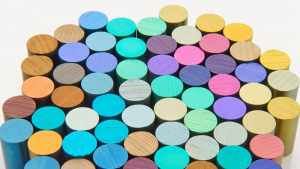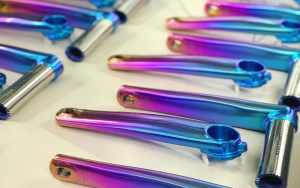
Titanium anodizing is an electrochemical process that creates a durable, corrosion-resistant oxide layer on the surface of titanium metal. Like the aluminum anodizing process, it can be used to change the color of titanium, as well as to improve its wear and abrasion resistance. Titanium anodizing is a popular choice for jewelry, watches, and other metal objects that see a lot of wear and tear.
Table of Contents
What is titanium anodizing?
Titanium anodizing is a process that creates an oxide film on the surface of the titanium. This film increases the corrosion resistance of the metal and can also change its color. The most common colors are black, blue, and gold, but other colors are possible as well. Titanium anodizing is often used to give medical implants a more aesthetically pleasing appearance. It can also be used for industrial applications where a corrosion-resistant surface is needed.
How does the anodize titanium process work?
The process of titanium anodizing involves using an electrical current to coat the metal with a protective oxide layer. This layer helps to prevent corrosion and wear, and can also give the metal a unique color. The process is often used on medical implants and other high-strength applications.
Titanium anodizing is usually done in an electrolyte bath, into which the titanium is submerged. An electrical current is then passed through the bath, causing the formation of the oxide layer on the metal. The thickness of this layer can be controlled by adjusting the current and/or the time that the metal is left in the bath.
After the anodizing process is complete, the metal is typically rinsed in water and then dried. The resulting oxide layer is usually very thin, on the order of just a few microns. However, it can be much thicker if desired. Titanium anodizing is a relatively simple and low-cost process, making it a popular choice for many applications.

What are the benefits of anodizing titanium?
Anodizing titanium offers a number of benefits, including improved corrosion resistance, wear resistance, and aesthetics. The process can also be used to create unique colors on the metal surface. Titanium anodizing is typically a low-cost and relatively simple process, making it a popular choice for many applications.
Corrosion resistance
Corrosion resistance is one of the most important benefits of anodizing titanium. The oxide layer that is created during the process acts as a barrier to oxygen and other corrosive elements. This helps to prevent the metal from degrading over time, even in harsh environments.
Wear resistance
Wear resistance is another key benefit of anodizing titanium. The oxide layer helps to protect the metal from abrasion and other forms of wear. This can extend the lifespan of titanium components, and make them better able to withstand repeated use.
Aesthetics
Aesthetics is another common reason for anodizing titanium. The process can be used to create a variety of different colors on the metal surface. This can be done by using different electrolytes, or by adjusting the current and/or time during the anodizing process. Titanium anodizing is a popular choice for jewelry and other decorative applications.
Overall, anodizing titanium offers a number of benefits that make it a popular choice for many applications. The process is relatively simple and low-cost and can improve the corrosion resistance, wear resistance, and aesthetics of the metal.
How can I anodize titanium at home?
If you want to anodize titanium at home, you’ll need to follow a few specific steps. First, you’ll need to clean the titanium surface that you want to anodize. Next, you’ll need to apply a layer of oxide to the titanium. Finally, you’ll need to anodize the titanium in order to create the desired effect.

- Cleaning the titanium surface is important in order to ensure that the anodizing process will be successful. You can clean the titanium using a variety of methods, but one of the most effective ways is to use a solution of vinegar and water. Apply this solution to the titanium surface and then scrub it with a soft brush. Once you’ve scrubbed the surface, rinse it off with water and dry it with a soft cloth.
- Next, you’ll need to apply a layer of oxide to the titanium surface. This can be done using a variety of methods, but one of the most effective ways is to use an electrolytic method. To do this, you’ll need to connect the positive lead of a power source to the titanium surface and the negative lead to a piece of aluminum. Apply a current to the setup and allow the oxide to build upon the titanium surface.
- Finally, you’ll need to anodize the titanium surface in order to create the desired effect. Anodizing titanium is a process that involves passing an electric current through the metal to create a thin oxide layer on the surface. This oxide layer can then be dyed or left uncolored. Anodizing titanium is a relatively simple process, but it’s important to follow the instructions carefully in order to achieve the desired results.
You can try different techniques to create a variety of effects, provided that you need to pay attention to safety. Anodizing titanium is a great way to add color and interest to your jewelry or other metal objects.

With a little practice, you’ll be able to create beautiful anodized titanium pieces that are sure to impress your friends and family.
Conclusion
Anodizing titanium is a process that can be used to change the surface of the metal to create a protective layer. This can be helpful in preventing corrosion and wear on the metal. This process involves passing an electric current through the metal to create the anodic layer. Anodizing titanium can be done at home with the proper equipment, but it is important to follow the instructions carefully to avoid damaging the metal.